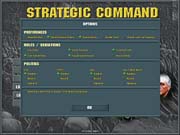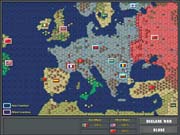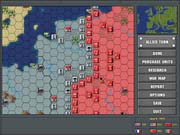Strategic Command: European Theater Preview
We take a look at Battlefront's latest wargame--this one portrays World War II on a massive scale.
These past few years have been a dream come true for gamers fascinated by World War II. We've been treated to award-winning WWII shooters, flight sims, and tactical wargames. World War II buffs are eagerly gearing up for forthcoming games like Battlefield 1942 and Combat Mission: Barbarossa to Berlin, too. Something that's been conspicuously absent from this great mix has been sophisticated games of grand strategy. You don't need to look far to find good tactical- or operational-level wargames about WWII. But what about a game that lets you control the fate of entire nations, maneuver whole armies across vast spaces, and delve into some of the political and economic aspects of war along with the combat itself? Thanks to Fury Software, this gap may be filled very soon with a promising-looking game called Strategic Command: European Theater.
Strategic Command will portray the conflict in the European theater on a massive scale. A single map hex will represent about 50 miles, or 80 kilometers. You'll wage war across spaces stretching from the East Coast of North America to the Ural Mountains of the Soviet Union, and from the sands of northern Africa up to just below the Arctic Circle. The game's time scale will be equally large. The exact amount of time represented by each turn will vary according to the season. During the militarily favorable months of summer, for example, turns will cover one week of action. During winter months, where harsh weather can wreak havoc on operations, turns will represent a whole month of time.
In Strategic Command, you'll get to lead six major powers: the UK, France, the United States, the Soviet Union, Germany, and Italy. Minor allies of these great nations will also play a role. You'll get to fight for ultimate supremacy beginning from several crucial junctures in the history of the war. The game's six campaigns will start as early as the invasion of Poland in 1939 or of France and the Low Countries in 1940. Events in the epic conflict between Germany and the Soviet Union will form the basis of three other campaigns: the launch of Operation Barbarossa in 1941, the conflicts around the Volga and Crimea in 1942, and the enormous Kursk offensive in 1943. The last campaign will begin with the well-known Allied invasion of Europe in 1944. Strategic Command will also ship with a campaign editor that will let you change initial control of hexes, add units where you choose, set production levels, and tweak other factors using a simple interface.

You'll get to determine just how close to history the game's campaigns play out, thanks to the inclusion of political stance options. You can elect to have nations enter the war at the same time they did historically, or you can have them remain neutral throughout the game. The latter should hopefully provide for some fascinating "what if" scenarios, with historically major powers sitting out on the sidelines, for example. You can also let nations enter the fray randomly, though their allegiances and the dates when they begin fighting will depend on how aggressively you play and whom you decide to attack. Invade the wrong nation or grab too much land too quickly, and you may turn potential allies against you.
Whatever campaign you decide on, you'll have the option to play against either the computer or another human. If you decide to challenge a friend, you'll get to play in either hotseat or play-by-e-mail modes. Fury Software promises free future support for LAN and TCP/IP play, too. When playing against the AI, you'll be able set the difficulty level and give enemy units an experience bonus for an added challenge. Fury is touting the game's AI as a sophisticated, proactive competitor. It won't merely go after obvious strategic targets you inadvertently leave undefended; it should also mount major offensive operations when you're not expecting them. In the preview build we got to play, the AI seems to act logically and stay on its toes, providing a solid challenge.
Military Might, a Mouse Click Away
In Strategic Command, you'll take control of truly mighty military units. For ground combat, you'll have Army HQ units, armies (60,000 to 100,000 men), corps (40,000 to 60,000 men), tank groups, and special rocket detachments. The latter, representing weapon systems like Germany's infamous V-1 and V-2 rockets, will be especially valuable assets, since their long-range attacks can't be defended against directly. Your only hope for defense will be to seek out and attack the rocket units before they can do harm.

Along with your ground units, you'll control air fleets representing tactically oriented aircraft, as well as strategic bomber groups for leveling cities and other crucial production resources from a distance. To control the sea, bombard the shore, and move land units across the water, you'll employ battleships, cruisers, carriers, subs, and transports.
Each of your units will be defined by some basic characteristics like strength, supply, and experience, as well as more specialized stats like tank defense or strike range, depending on the unit type. Interestingly, your HQ units will be based on and named after real-world generals. This means you'll get to lead forces under famed commanders like Patton, Rommel, Zhukov, and others. These HQ units will play a major role in the effectiveness of your troops, influencing the morale and combat readiness of subordinate units.
You'll begin with only a handful of simple unit types that on the surface might not sound particularly exciting. However, thanks to Strategic Command's research options, you'll get to boost your units beyond their basic capabilities, creating a unique force to serve your strategic needs. With the game's fundamental currency, military production points, which you gain from your intact cities, ports, mines, and the like, you'll be able to invest in 11 different types of research. Antitank research, for example, will improve the maximum strength and tank defense values for corps and armies. Sonar research will help your surface warships defend against perilous sub attacks. To reflect the added expense of building units that have been improved through research, the production costs of these units will increase, though you can offset this by investing in industrial technology itself.

These sorts of fundamental, long-term strategic decisions will play a major role in Strategic Command. While it's a historically based war simulation, it won't force you to wade through the minutiae that can make many smaller-scale wargames seem more like work than play. Instead, Strategic Command seems to be more along the lines of the popular board game Axis & Allies, but with more historical realism and sophistication. To issue standard land movement orders, for example, you'll only need to take into account a few basic factors like penalties from rugged terrain or nearby enemies.
But you'll still be faced with plenty of challenging decisions. For example, if you want to move units more rapidly via rail, you'll need to make sure your units' current and destination hexes are linked by unbroken friendly territory, and you'll also need to spend valuable production points for such an expedited operational maneuver. As another example, you'll need to decide how to employ your potentially decisive air power. Do you risk losing it to interceptors as you pound strategic targets early on, or do you hold back and use it later to help cover an invasion force?
Movement and combat in Strategic Command will be brought to life with some very simple visuals and sound effects. The game definitely looks to be more of a treat for the mind than the senses. Considering the number of games that emphasize empty audio-visual fluff over deep content, this will surely be a welcome trade-off for many gamers. You'll get to test Strategic Command's merits--and your own wits--when the game ships later this month.
Got a news tip or want to contact us directly? Email news@gamespot.com
Join the conversation